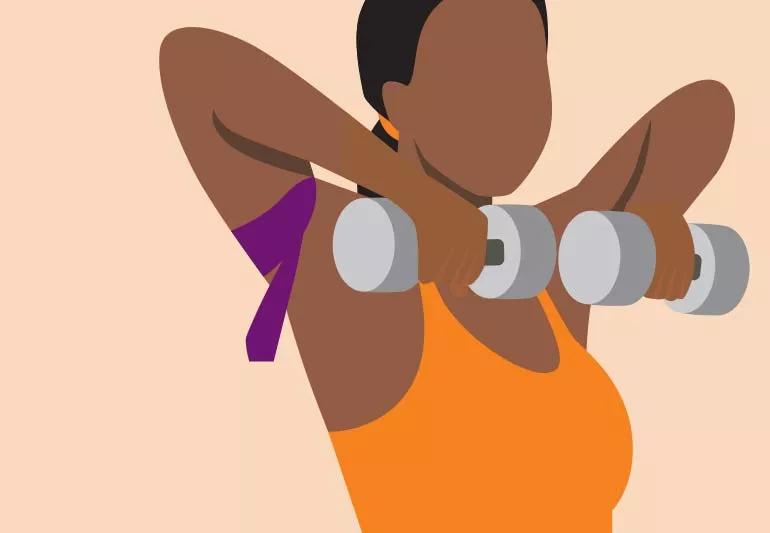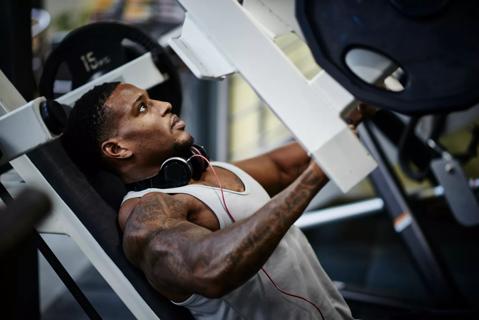Use tightened BFR bands to build muscle faster with less heavy lifting in your workout

A new training technique that embraces the concept of working out “smarter, not harder” allows you to exercise at a lower intensity and still make progress.
Cleveland Clinic is a non-profit academic medical center. Advertising on our site helps support our mission. We do not endorse non-Cleveland Clinic products or services. Policy
The method is called blood flow restriction (BFR) training — and it’s exactly what it sounds like.
“A special kind of tourniquet (elastic band) goes around your thigh or arm to reduce the blood flow out of that area,” says physical therapist Meghan Brady, DPT, who is certified in BFR. “It tricks your body into thinking you’re working harder than you are.”
The result? You can use less weight to build strength and muscle mass.
“BFR training can be a great addition to your fitness routine, especially during an active recovery week,” she continues. “It’s also helpful for people who can’t lift enough weight to support muscle growth, like people with osteoporosis or those undergoing surgery.”
To explain the basics of BFR, or occlusion training, let’s hear more from Brady, as well as exercise physiologist Chris Dempers, EP-C, and certified personal trainer Michael Bellace, C-PT.
The idea of “no pain, no gain” isn’t too far off from what science tells us about the process of muscle growth, or muscle hypertrophy. When you strength train, you change the environment inside your muscles and this activates muscle hypertrophy.
Muscle growth happens through:
With BFR training, blood still comes into your muscles via your arteries. The use of the band, however, blocks it from leaving through your veins. This restriction of normal blood flow allows your muscles to experience swelling, fatigue and oxygen depletion more quickly.
“It creates the same muscle environment that regular strength training does — but while using less weight and working at a lower intensity,” explains Dempers. “Muscle hypertrophy takes place because your body has been tricked into thinking it’s working harder than it is.”
Here’s another way to look at it: “Your muscle reacts to a small load as if it’s much larger using BFR training,” says Bellace. “It recruits the fast-twitch muscle fibers that you normally only use for lifting a strenuous amount of weight or lifting weight quickly. Those kinds of muscle fibers bulk up more quickly.”
A variety of tourniquet-type tools, including BFR bands, are available for BFR training.
If you do BFR during physical therapy, your therapist will most likely use something that resembles a blood pressure cuff. This type of BFR tool lets your therapist monitor your blood pressure and percent of blood flow restriction while you train.
Basic BFR bands are less involved. They are typically straps or bands that tighten around a limb. Some come with kits that measure blood pressure, but those can get expensive.
“BFR bands fit looser than what medical professionals use,” notes Dempers. “You also have to manually restrict your blood flow, which leaves a lot of room for operator error. But you can do it safely.”
Bellace and Dempers explain four things you should know when using BFR bands for muscle hypertrophy:
If your exercise regimen were a meal, BFR training would be a side dish. “If you can do regular strength and resistance training on your own, that should trump blood flow restriction training,” says Bellace. “Think of BFR training as a complementary tool to add to your toolbox.”
Bellace recommends working BFR into the weeks you use for active recovery. During active recovery weeks, you still work out but with less weight and for less time.
“Go hard for three or four weeks at a time, then use BFR training to take the intensity down for a week,” he advises. “This gives your joints and ligaments a break while maintaining your muscle gains.”
Only use BFR bands on your arms and legs. “For your arm, wrap it between your shoulder and bicep muscle, but do not put it directly on top of your muscle,” says Bellace. “For the legs, wrap them around the top of your thigh as close to your groin as you comfortably can.”
Everyone’s different. That’s why how tight you wear your bands should be personalized to you. An athletic trainer or physical therapist experienced in BFR can help you find your sweet spot using special tools.
Also, as an FYI: You might hear the tightness of bands referred to as blood flow restriction percentage or limb occlusion pressure (LOP).
Experts typically recommend between 30% and 50% restriction percentage for arms and between 50% and 80% for legs. On a 1 to 10 scale, with 10 being maximum tightness, Bellace says to aim for a seven when using BFR bands alone.
Bellace also says the key is to not overdo it. Wear BFR bands between eight and 20 minutes while working your legs or arms. Then give yourself 30 seconds with no pressure before moving on to the next exercise for that muscle group.
“If you do that, you’ll definitely see some benefits,” adds Dempers.
Benefits of using BFR bands include:
All three experts agree that most people can do BFR training safely, though there are instances where it wouldn’t be recommended. Health conditions that make BFR training a no-go include:
Dempers recommends working with a professional who can teach you how to use BFR bands effectively and safely. “Look for someone who can do a health history on you. Then, you can be sure you don’t have any health conditions that would make BFR training unsafe.”
Learn more about our editorial process.

Chair exercises can help people age 65+ retain independence

Both are needed for a healthy body

Counteract psoas muscle stiffness and soreness with stretches that lengthen and strengthen

It may be OK, depending on your health, fitness level and type of exercise

Simple exercises like wall angels and pelvic tilts can help keep your body in an optimal position — and help undo years of improper posture habits

Losing belly fat can reduce your risk for chronic health conditions — try focusing on a diet high in lean protein, exercising regularly, reducing stress and getting quality ZZZs

It’s best to exercise before or after your fast, instead of during it

Absolutely! In fact, in many ways, exercise is key to recovery

Your metabolism may torch 1,300 to 2,000 calories daily with no activity

A gentle touch in all the right places may help drain your sinuses